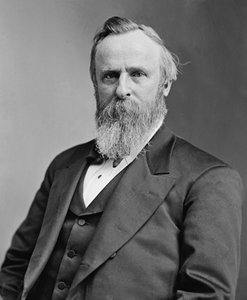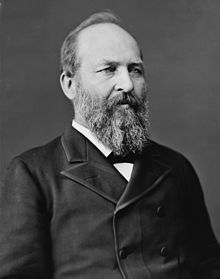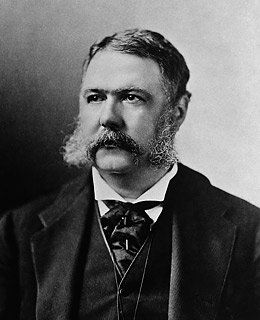Triumph of Industry in the United States, 1865-1893

Rutherford B. Hayes

James A. Garfield

Chester Arthur
Industrial expansion was well underway before the Civil War, which slowed or deviated it, and was the
most important "event" of the post-Civil War period. It would transform the United States and, thus the
history of the world. It was not unique, however, for industrialization had been occurring in England since
the 18th century, Belgium and France since the early 19th century, and in Germany and Japan after 1870. US
industrialization was larger in scale and transformed US culture more profoundly than the other cultures.
The US had long been exploiting its unique advantages for economic growth. Since 1815, it had been more and
more driven by market forces. Within its borders, it had nearly all the necessary raw materials, a rapidly expanded
national market, a growing labor force swelled by natural increases and immigration. By the 1850s, the
agricultural revolution with its mechanization freed workers to go to urban areas while increasing the output of
food and fiber to supply workers and factories. Not only did domestic sources supply capital but also Europeans,
especially Dutch and British sources. People in the country had inventive genius and managerial skills. The US
railway network was the world's largest and was the nation's single most important industry. The transportation
system east of the Mississippi River was adequate and, in the 1860s, the railway network was extended to
California.
Legislation passed by the Republican Party while their pro-agriculture rivals, the Democratic Party, were
weakened by the secession of Southern Democrats, aided industrialists and other businessmen. They raised the
taxes on imports to new highs in 1861; the South had opposed protective tariffs because that region was hurt by
them. In 1863, they created a national banking system. Gifts of lands and cheap loans subsidized the building of
transcontinental railroads. Workers were imported with contracts signed abroad, paying for their transportation by
pledging their first year's wage. This was so controversial that it was repealed in 1868, four years after the law was
passed, and outlawed in 1884. The US government had increased the supply of capital during the Civil War
through massive borrowing and the issuance of Greenbacks, money not backed by precious metal. Bankers and
speculators profited and, thus, had capital to invest in industrial enterprises or loan to investors.
Conditions of Growth
The agricultural revolution, which preceded the industrial revolution, occurred as farmers expanded onto new
lands, used labor-saving machines which allowed them to cultivate more acres with fewer people, utilized new crop
varieties, and took advantage of new food processing facilities. Wheat processed in Minneapolis fed people in
Great Britain.
This expansion of agriculture occurred in other places as well and provided staunch competitors for US
agriculturalists. For example, Argentina became one of the world's foremost producers of both wheat and beef.
Australia and Russia competed against US farmers. After 1869, farm prices fell because of increased efficiencies by
US producers and this international competition.
New mineral resources—iron, coal, petroleum, gold, silver, industrial metals—were exploited.
US technology provided the means to improve production. US inventors were especially good in
communication technology—railroads, wagons, telegraph, telephone, etc,—because distance had to conquered in
the vast land.
The number of people, who are both producers and consumers, expanded. Whereas there were 38,500,00
people in the 1870, there were 76,000,00 in 1900. Of these, 12,000,000 were immigrants, ambitious people who
were brighter-than-average and more ingenious. Because the "sending" societies have to pay to raise the person to
the age of immigration, an immigrant represents a capital investment in the "receiving" country by the "sending"
country. Thus, US industrialization and economic growth in general, was strongly but unintentionally subsidized
by foreign societies.
Foreigners also invested in the US for it had a stable government, paid its debts, provided good returns on
investments, and had sufficient amounts of its own capital to insure that investors would be able to get their monies
back. Between 1869 and 1898, some 13% of national income went to investment!
Demand seemed inexhaustible, thus favoring the growth of large-scale enterprise. As urban populations
grew and their incomes went up, they bought more and more consumer goods and ate better, often consuming
processed foods. The expansion of agriculture and industry needed machines. Better transportation facilitated
concentrating these machines into a single place, which also encouraged large-scale enterprise as well. Certain
industries, such as steel, required such expensive machinery that fixed costs were very high and could only be paid
by a few and which necessitated running the production facilities 24 hours a day, 7 days a week. This, of course,
created bigness. Because prices declined in the period, enterprises had to become more efficient and cur costs in
order to survive. The depressions of 1873-79 and 1893-97 squeezed weak competitors out.
Bigness could take a number of forms and used involved trying to get a monopoly. Although businessmen
and industrialists usually argue in favor of free enterprise or competition, they , like others, prefer to have a
monopoly on whatever economic activity they do. Individual ownership and partnerships rarely were able to
finance large-scale enterprise. In order to jack up prices and stifle competition, some businessmen resorted to
"pools," gentlemen's agreements to fix prices. But greedy men are not gentlemen, so the pools tended to break up
as one or more members betrayed his fellow members and cut prices. The trust was designed to be a policing
mechanism, for the members entrusted trustees with enough stock to control the constituent companies. However,
this practice, questionable in Anglo-American law, came under sever attack and was outlawed, ostensibly, by the
Sherman Anti-Trust Act (1890). Before anti-trust legislation became a problem, corporation lawyers had found a
solution—the holding company. These corporations (today very common) exist to but enough stock in companies
to control them. In some cases, this would mean a majority of the stock. In companies with millions of shares, as
little as 10 of the outstanding stock would be sufficient. To control a company only required having a majority of
stock present and voting at the stockholders' meeting. Holding companies could combine the assets of the
companies they controlled to buy another, larger company. Managerial skill, including this manipulation of
ownership, helped create giant corporations.
The great industrialists had little in common except that most had above average educations and came
from families with above average incomes. Few were like Andrew Carnegie, who went from very modest
circumstances to enormous wealth; they more closely resembled J. P. Morgan, the investment banker whose father
was an investment banker. Some were gentlemen; some were crooks; some were both. The myth grew, however,
that anyone could become rich if he (rarely seen as she in this period) worked hard, practiced frugality, invested his
money, an lived a clean life.
The Achievement
By the end of the 19th century, the US was the greatest producer of wealth the world had ever seen. The
railroad system was the most spectacular. The US produced huge quantities of agricultural products and industrial
goods. In steel, for example, the -US produced as much as Great Britain and Germany, the 2nd and 3rd largest
producers combined. Similarly US-made consumer goods were sold throughout the world. Shoes were made by
machines sold by the United Shoe Machinery Company.
Social Effects
Machine production and processing drove out small operations such as village butcher.
By the 1890s, more leisure time and higher incomes gave rapid rise to sports, both participatory and
observational. There were increase in literacy and a sharp increase in high school education. Cheap magazines,
newspapers, and dime novels, including Westerns which romanticized the West, became common. The bicycle
craze caught the US fascination with machines and speed. From 1865 to 1900, real wages went up by half. Work
hours declined from 11 to 10. The nation was becoming urbanized with 405 of the population living in urbanized
areas by 1900.

